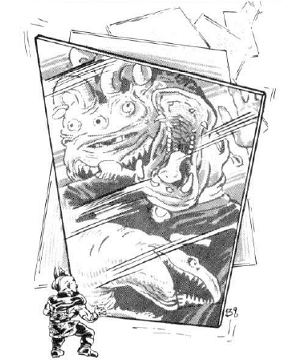

2109

| Climate/Terrain: | Any space |
|---|---|
| Frequency: | Very rare |
| Organization: | Solitary |
| Activity Cycle: | Always |
| Diet: | Light and magic |
| Intelligence: | Unknown |
| Treasure: | Nil |
| Alignment: | Neutral |
| No. Appearing: | 1 |
| Armor Class: | -1 |
| Movement: | Fl 1 to 24 (A) |
| Hit Dice: | 6-13 |
| THAC0: | 6 HD: 15 7-8 HD: 13 9-10 HD: 11 11-12 HD: 9 13 HD: 7 |
| No. of Attacks: | Area of effect (1 sq. ft. per HD) |
| Damage/Attack: | 2-8 |
| Special Attacks: | See below |
| Special Defenses: | See below |
| Magic Resistance: | 25% |
| Size: | H (1 sq. ft. per HD) |
| Morale: | Fearless (20) |
| XP Value: | 6 HD: 2,000 (+1,000 per additional HD) |
Fractines appear as two-dimensional, mirrored, trapezoidal planes. When at rest, fractines resemble vast mirrors and can be manipulated to function as excellent scrying mirrors. To do so, a spelljamming scholar must focus his willpower on the subject he wishes to view, while touching a fractine. A Wisdom check (modified by a DM-selected difficulty penalty of -1 to -10) must succeed to view the subject. Failure results in 1d10 turns of exhaustion and a 10% chance that the fractine is stirred into motion, One can examine a subject’┐Įs past, future, and weaknesses using the right techniques. However, the fractine’┐Įs distorted surface may blur the results, obscuring crucial information.
Fractines are most commonly encountered in space in an active state, tumbling or folding and refolding like a piece of origami. They react to a variety of stimuli. They are attracted to motion, loud sounds, and magical energy. However, large bursts of energy (such as a fireball or lightning bolt) repulse fractines for 1d4 rounds. Spells affecting air can be used to control fractines. (The caster must roll a successful saving throw vs. spell each round or lose control.)
Combat: A fractine causes a variety of harmful, distortional efects. Physical attacks may be used to destroy or alter its course, but only silver or magical weapons or spells cause any damage. Furthermore, a fractine must be struck on one of its two faces to cause any damage.
Any physical damage to a fractine causes damage to the attacker. The attacker suffers 1d4’┐Į25% of the inflicted damage (round fractions up), though he receives a saving throw vs. petrification to suffer only half damage.
Once per round there is a 1% chance per point of damage inflicted that a fractine shatters into 1d4 independent fragments, each with one-third of the remaining HD and hp (shattering releases any held creatures).
A fractine receives a saving throw vs. any magical effect, if the effect gets past its magic resistance. If the saving throw is successful, the magical effect is redirected at random.
A fractine attacks by falling on its targets. The fractine passes through its victims, causing 2d4 points of damage and forcing a saving throw vs. breath weapon to avoid a special effect. If the saving throw fails, roll 1d20 for the effect.
| Roll | Effect |
|---|---|
| 1-3 | Blink (random direction and orientation) |
| 4-5 | Teleport (1d4’┐Į10 feet into air) |
| 6-7 | Deport* (Character’┐Įs mind views his body from another plane; must roll Wisdom checks each round to control) |
| 8-9 | Turn ethereal* (AbIe to cast magic only, intangible) |
| 10-12 | Distortion* (Character’┐Įs form suffers a distortion, DM’┐Įs choice ’┐Į Effects may shorten or lengthen limbs, make fat or thin, flatten, stretch, etc. A Dexterity check must succeed each round to perform any desired actions. |
| 13 | Transpose* (Part of body is exchanged with that of another victim, or it vanishes. Roll an Intelligence check to control body part.) |
| 14 | Reversed* (Any action the character takes becomes reversed) |
| 15 | Duplication** (Creates a duplicate of character; duplicate attacks) |
| Trap (As a mirror of life trapping; there is a 25% chance that another creature is released at the same time) |
* Effect lasts 1d4 rounds.
** Effect lasts 2d4+2 rounds.
Habitat/Society: It is not known whether fractines are intelligent creatures or merely spatial phenomena. Shattered fragments either follow divergent paths or merge once again.
Ecology: Fractines consume life, light, darkness, and magical energy. Each level, Hit Dice, spell level, and bonus provides 1 point of food. When a fractine has consumed a number of points equal to its total hit points, it leaves. Its movement rate is increased by 1 per point of light consumed and decreased by 1 per point of darkness (maximum of 24 and minimum of 1).
Last Modified: April 22, 2009, 13:50:38 GMT

◆ 725 ◆